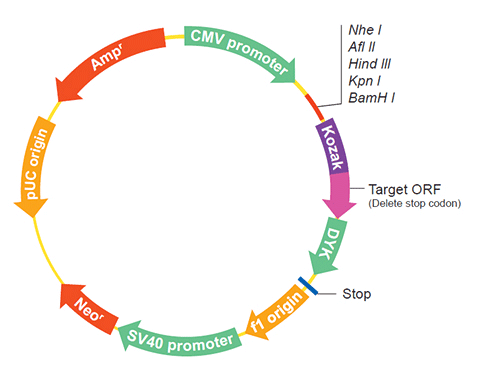| Gene Symbol | ACTB |
| Entrez Gene ID | 574285 |
| Full Name | actin beta |
| Gene Type | protein-coding |
| Organism | Macaca mulatta(Rhesus monkey) |
HOME
ORF » Species Summary » Macaca mulatta » ACTB cDNA ORF clone
| Gene Symbol | ACTB |
| Entrez Gene ID | 574285 |
| Full Name | actin beta |
| Gene Type | protein-coding |
| Organism | Macaca mulatta(Rhesus monkey) |
| mRNA | Protein | Name |
|---|---|---|
| NM_001033084.1 | NP_001028256.1 | actin, cytoplasmic 1 |

| Homo sapiens (human) | ACTB | NP_001092.1 |
| Gallus gallus (chicken) | ACTB | NP_990849.1 |
| Anopheles gambiae (African malaria mosquito) | AgaP_AGAP011516 | XP_315269.4 |
| Pan troglodytes (chimpanzee) | ACTB | NP_001009945.1 |
| LOC100428865 | XP_002802770.1 | |
| Rattus norvegicus (Norway rat) | Actb | NP_112406.1 |
| Anopheles gambiae (African malaria mosquito) | AgaP_AGAP005095 | XP_313971.4 |
| Oryza sativa (rice) | Os05g0438800 | NP_001055661.1 |
| Canis lupus familiaris (dog) | ACTB | NP_001182774.1 |
| Drosophila melanogaster (fruit fly) | Act57B | NP_523800.1 |
| Xenopus tropicalis (tropical clawed frog) | actb | NP_998884.1 |
| ACTB | NP_001028256.1 | |
| Mus musculus (house mouse) | Actb | NP_031419.1 |
| Bos taurus (cattle) | ACTB | NP_776404.2 |
| Drosophila melanogaster (fruit fly) | Act87E | NP_731812.1 |

A new rhesus macaque assembly and annotation for next-generation sequencing analyses.
Zimin AV, Cornish AS, Maudhoo MD, Gibbs RM, Zhang X, Pandey S, Meehan DT, Wipfler K, Bosinger SE, Johnson ZP, Tharp GK, Mar?ais G, Roberts M, Ferguson B, Fox HS, Treangen T, Salzberg SL, Yorke JA, Norgren RB Jr
Biology direct9(1)20(2014 Oct)
Characterization of the bombesin-like peptide receptor family in primates.
Sano H, Feighner SD, Hreniuk DL, Iwaasa H, Sailer AW, Pan J, Reitman ML, Kanatani A, Howard AD, Tan CP
Genomics84(1)139-46(2004 Jul)
Elevated gene expression levels distinguish human from non-human primate brains.
C?ceres M, Lachuer J, Zapala MA, Redmond JC, Kudo L, Geschwind DH, Lockhart DJ, Preuss TM, Barlow C
Proceedings of the National Academy of Sciences of the United States of America100(22)13030-5(2003 Oct)
GeneRIFs: Gene References Into Functions What's a GeneRIF?
The following ACTB gene cDNA ORF clone sequences were retrieved from the NCBI Reference Sequence Database (RefSeq). These sequences represent the protein coding region of the ACTB cDNA ORF which is encoded by the open reading frame (ORF) sequence. ORF sequences can be delivered in our standard vector, pcDNA3.1+/C-(K)DYK or the vector of your choice as an expression/transfection-ready ORF clone. Not the clone you want? Click here to find your clone.
| CloneID | OMb00948 | |
| Clone ID Related Accession (Same CDS sequence) | NM_001033084.1 | |
| Accession Version | NM_001033084.1 Latest version! | Documents for ORF clone product in default vector |
| Sequence Information | ORF Nucleotide Sequence (Length: 1128bp) Protein sequence SNP |
|
| Vector | pcDNA3.1-C-(k)DYK or customized vector |  User Manual User Manual |
| Clone information | Clone Map |  MSDS MSDS |
| Tag on pcDNA3.1+/C-(K)DYK | C terminal DYKDDDDK tags | |
| ORF Insert Method | CloneEZ™ Seamless cloning technology | |
| Insert Structure | linear | |
| Update Date | 2019-04-27 | |
| Organism | Macaca mulatta(Rhesus monkey) | |
| Product | actin, cytoplasmic 1 | |
| Comment | Comment: PROVISIONAL REFSEQ: This record has not yet been subject to final NCBI review. The reference sequence was derived from CB554252.1, AY497558.1 and AY369786.1. ##Evidence-Data-START## RNAseq introns :: single sample supports all introns SAMN10394820 [ECO:0000348] ##Evidence-Data-END## | |
1 | ATGGATGATG ATATCGCCGC GCTCGTTGTC GACAACGGCT CCGGCATGTG CAAGGCCGGC |
The stop codons will be deleted if pcDNA3.1+/C-(K)DYK vector is selected.
| RefSeq | NP_001028256.1 |
| CDS | 26..1153 |
| Translation |

Target ORF information:
Target ORF information:
|
 NM_001033084.1 NM_001033084.1 |

1 | ATGGATGATG ATATCGCCGC GCTCGTTGTC GACAACGGCT CCGGCATGTG CAAGGCCGGC |
The stop codons will be deleted if pcDNA3.1+/C-(K)DYK vector is selected.
A new rhesus macaque assembly and annotation for next-generation sequencing analyses. |
Characterization of the bombesin-like peptide receptor family in primates. |
Elevated gene expression levels distinguish human from non-human primate brains. |